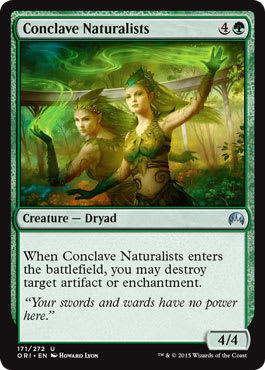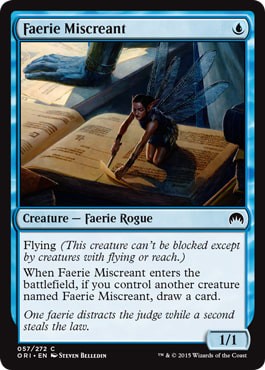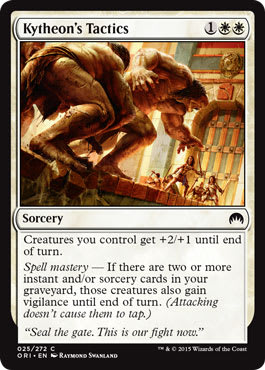The full Card Image Gallery for Magic Origins has finally been revealed to us all. If you have not taken the opportunity to bask in all of its Vorthosian glory . . .

Image found here
Magic Origins will always hold a special place in my heart, as it was the first set that I contributed names and flavor text to as a freelance writer for Magic. The set served as the stage for my own sort of origin story, affording me the opportunity to contribute to my favorite game. It is because of Magic Origins that I can confidently call myself a writer. The wait is finally over, and I am so excited to be able to finally share some of my experiences with you all.
In honor of the upcoming Origins prerelease events taking place this upcoming weekend, I sat down with the creative lead of Magic Origins himself, Mr. Ari Levitch. It turns out that this set served as a sort of origin story for Ari as well, as this was his first set serving as the creative lead. I hope you enjoy Ari’s answers to the following questions, and that they serve as a way for you all to better get to know one of the hard-working members of Wizards of the Coast story team.
Tell us a little bit about yourself. Who are you, and what is your current position?

My name is Ari Levitch. Currently, I have the honor of working as a member of Magic: The Gathering’s story team. A little bit about me: I will never get tired of watching the movie Willow. I will probably be buried with a d20 clenched in my fist. And I’m convinced that mustard is the Devil’s work.
How did you get into Magic? What is your origin story?
I can’t remember when fantasy wasn’t a big part of my life. Reading the Dragonlance Chronicles in fifth grade was one of the formative experiences of my childhood, so it was a pretty easy sell when, in 1994, a friend of mine visiting from New Jersey introduced me to Magic. I remember being enamored with Sea Serpent, and Winter Orb was my first rare. In retrospect, it’s a miracle I stuck with the game. But I did. It was probably due to my lifelong, and some say unhealthy, love affair with mill decks that all began with a play set of Millstone—that, and Magic is what brought my friends together around a table every weekend throughout middle school and high school.
 |  |
How did you get your start working for Wizards of the Coast? What were you doing before you were a wizard?
Before becoming a wizard, I was working as a high-school history teacher in southern California. To scratch the creative itch, my brother and I wrote a superhero-inspired fantasy comic book series that we peddled at Comic-Con for several years. In 2012, a friend of mine put me in touch with Magic’s writing team, and I began working as an external contractor on names and flavor text for Magic 2014. A few months later, an internship position opened up, and I went for it. The team decided I wasn’t wrecking anything too terribly, and the internship turned into a fulltime job.
You were the creative lead for Magic Origins. What does that mean? What were your responsibilities?
Generally speaking, the role of the creative lead of a set is twofold. They act as the liaison between the creative team and the design team. In this case, once the design team settled on Planeswalker origins as the theme of the set, my job was to inform the designers and developers about the Planeswalkers’ origins and to foster excitement for them. That meant that I actually needed to know what those stories were going to be.
Given the time pressure, and the stakes, I leaned on the story team for support. Each writer took a character to develop, and we even got a James Wyatt from D&D (who would later join the team) to chime in for Liliana. The outlines they produced eventually turned into the origin stories that went up on Uncharted Realms. The outlines provided the framework for capturing the essential story moments that would ultimately end up in the card set. They also informed the fight progressions and storylines in Duels. As the set and stories became more concrete, my job was mainly to monitor the card file and Duels experiences for inconsistencies between card mechanics and the set’s creative elements. At times, this meant being the fun police on the design and development teams.
The other major responsibility of the creative lead is the “concepting” of the cards. That means looking at the mechanics of each card and writing art descriptions for them. The art directors then take those “concepts” and commission artists to paint them. Typically, there is the benefit of World Guide to point to for reference material, but Magic Origins has ten planes, so this added layers of complexity to the concepting and commissioning processes. It was a ton of cards, with a ton of constraints. Also, this was the first set that I concepted. That said, I’m pretty sure I was walking around with perma-grin when the art started coming in. It was a surreal experience to have artists that I admire paint pictures from my words.
In addition to being the set’s creative/design go-between and conceptor, I was able to stretch my card-design muscles. During playtests of the set, it meant being painfully aware that my skill as a Magic player is amateur at best. I have yet to beat Ian Duke.

This was your first time being creative lead for a set. What was your mindset going in at the beginning? Were you nervous/excited/both/neither?
Definitely excitement more than nerves, going into it. When I was assigned to the project, it was intended to be the next core set. I’d only been with the story team about seven or eight months, and my manager at the time, Colin Kawakami, said, “It’ll be a great way to get your feet wet.” Halfway through the design process, it was decided that Magic would be moving to a two-set block structure, and this set would be the final core set. We saw an opportunity to use it to kick off the new approach, which included our approach to storytelling. The creative team was already developing its plans for Magic’s storyline, so the idea of Origins fell out of that. Suddenly, the set was a really big deal. So yeah, I’d have to say that whatever the unit of measurement is for nervousness increased significantly. But so too did my excitement. The fact that they kept me as the creative lead was a tremendous testament of trust that I was driven to justify.
What were your goals for the creative design for this set?
The creative goals for Magic Origins are pretty straightforward: Reintroduce the five Planeswalkers who will be major players in our story. Show where they came from and how they became Planeswalkers in the first place. Make them relatable people, with clear motivations.
Looking back, how would you rate your overall performance as creative lead? What do you think you did well? What do you hope players will take away from the set?
Um . . . 10/10. Next question.
In all honesty, it’s very difficult for me to evaluate at the moment. A lot of it will depend on whether fans connect with our characters and desire to follow the story that’s about to unfold. All I can say is that I’m proud of the set as a whole—as well as of my hand in it. Origins is a special set. Just as it was my first time as a creative lead, it was also Shawn Main’s first time as a design team lead and Sam Stoddard’s first time as a development team lead. Origins indeed!
Give us a brief idea of your creative process. What’s it like to be inside the head of Ari Levitch? Do you keep an idea notebook or anything?
In terms of the creative process, it depends on the project. Writing a story typically starts with a lot of walking and talking out loud, resulting in frantic voicemails that I leave myself with the hope that they will be coherent enough to bend into a serviceable outline. From there, it’s all about grinding away at a keyboard and putting the backspace button to work.
Designing worlds is where I feel the most in my element, as I am able to tap into my experience with, and unabashed love for, history. I have more books on history than a person should, and there’s little I enjoy more than sifting through their pages for inspiration. I keep a notebook (or several) for the task of recording historical episodes, characters, and symbols, with an out for cultural details that inform a society’s worldview because this usually serves as the nugget that can yield a new and rich fantasy setting.
Are you constantly thinking about ideas for Magic storylines, characters, and worlds or are you able to “switch off” the creativity brain when you get home?
The story team is cooking up some amazing things that I’ll admit I geek out over. It’s hard not to continue thinking about this stuff after work, or before work, or on weekends, or on vacation. That said, we’re working on so many projects at any given time that I have found it necessary to carve out time to recharge. Sometimes, that means going on a hike, playing games, taking in a movie, razzing my cats, or watching the Dodgers. Most often, it means reading.

Ari’s cats Pippin and Yue. (Pippin is the big one.)
What were some things that served as inspiration for you when working on this set? Movies, TV shows you watched, or books you read? Works of art or music?
I’m trying to remember what I was reading at the time, and I can only shake my head with a tinge of regret that I actually had no time to read during the fevered marathon that was Magic Origins. That said, whenever I write prose for the story team, an inevitable piece of feedback is that it feels like a comic book. What can I say? Comics were my first serious attempt at narrative storytelling, and the influence is pretty sticky. For Magic Origins, the inspiration is pretty direct. Every superhero has an origin story, and now it’s our turn to tell our heroes’ stories.
When I wrote the art descriptions, my soundtrack typically broke down as follows:
- Gideon-related cards: Gladiator OST
- Jace-related cards: Inception OST
- Liliana-related cards: Batman Begins OST
- Chandra-related cards: Willow OST
- Nissa-related cards: Last of the Mohicans OST
What was your general approach when dealing with continuity issues? Did creative attempt to stay pretty close to current cannon or were you free to make adjustments when necessary?
When we set out to craft our Planeswalkers’ origin stories, we knew we didn’t want to just toss out the existing cannon. We knew more about some characters than others, so to some degree, we were beholden to aspects of established lore. For example, we knew from the web comic that Liliana was directly responsible for turning her brother into a horrible monster. For Magic Origins, however, we emphasized character motivation, so our approach was that whatever story we’re going to tell has to push the Planeswalkers toward becoming the characters we know. For Liliana, James Wyatt explored her fear of mortality. When her monster-of-a-brother attacked her, she is confronted with the prospect of her own death, and it terrifies her. It shapes her motivation to delve deeper into necromancy—and ultimately to enter into a demon pact. We tried to tell stories that didn’t invalidate the lore and that, at the same time, established the Planeswalkers to be rich characters with their own goals, fears, and vulnerabilities.
Cards like Unholy Hunger and Archangel of Tithes allow players to experience key story moments in game via gameplay, similar to using Savage Punch on a Surrak targeting a bear. Was this a goal from the beginning? If yes, how did you plan for including such moments, and what is the process like working with design on them? If no, how do these things come about? Are they more just spur-of-the-moment ideas?
The answer is somewhere in between. The goal was to set ourselves up to be able to include rewarding story moments that would allow people to experience the narrative in both the paper game and in Duels. During design, we knew we were going to include cycles that reflect key moments in all of the Planeswalkers’ respective stories. The rare legendary cycle emerged from this approach. Shawn Main, the lead designer for Origins, was interested in showing all the Planeswalker at various stages of their development as spell-casters, and that became the impetus for the three cycles of spell mastery. At common, we see each character on their home-plane, in their pre-Planeswalker forms. At uncommon, they are on the planes of their first planeswalks, and at rare, we see them pretty close to their modern selves. The double-faced legendary-to-Planeswalker cards are easily the cards that most loudly scream that the set’s theme. All of these were intentional, which was super-helpful when I sat down to write art descriptions for the set.
The design and development teams were both enthusiastic about delivering on the creative vision of the set, and many of the story-relevant cards emerged organically as a result. To a degree, it was opportunistic, as the creative needs of Duels took shape and the Origins stories themselves were being written. This was how cards like Archangel of Tithes and Unholy Hunger ultimately took their final shapes. Other cards with narrative connections include Ampryn Tactician and Send to Sleep from Jace’s story as well as Boggart Brute, Gather the Pack, and Eyeblight Massacre from Nissa’s.
A personal favorite of mine is Kytheon's Tactics, which is a direct callback to Desperate Stand from Journey into Nyx, which was the first time we saw the name Kytheon Iora.
I’m convinced that it took buy-in from design and development to make the creative vision successful here. Sam Stoddard, the set’s lead developer, was a great advocate for story, and it truly made my job a lot easier knowing that we both shared the same vision.
Your current home plane is doomed. Where do you planeswalk in order to make a new life for yourself?
I think I go to Ravnica for its amenities and relative stability, but with a stopover on Innistrad for the wardrobe. Those jackets!
 |  |
A big thank you to Ari for taking the time to answer these questions! I hope you all enjoyed this very special snack time with Ari. Until next time, may Magic serve as the origin for your own adventures.
-Ant






























